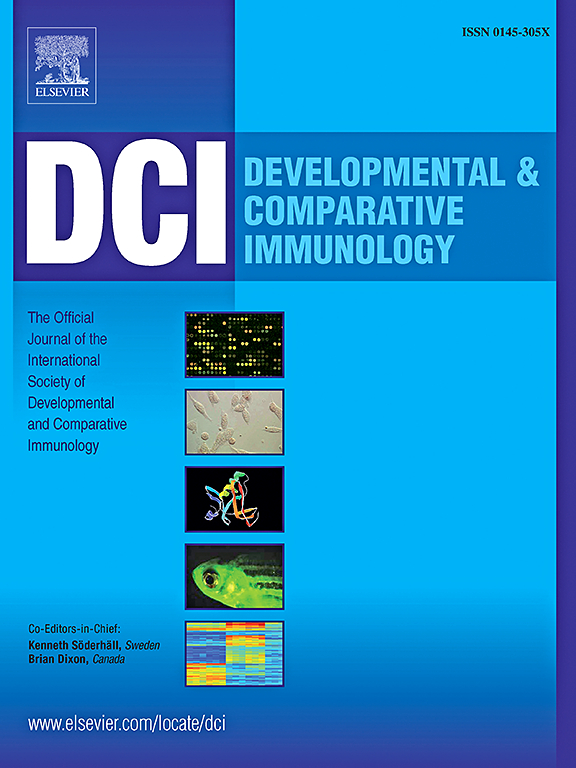Chitosan-selenium nanoparticles suppress infectious spleen and kidney necrosis virus through immune modulation and viral replication inhibition in zebrafish (Danio rerio)
IF 2.7
3区 农林科学
Q1 FISHERIES
引用次数: 0
Abstract
Infectious spleen and kidney necrosis virus (ISKNV) is one of the most challenging diseases causing substantial financial losses in global aquaculture. However, effective strategies for controlling ISKNV infections in ornamental fish are lacking. In this study, chitosan-selenium nanoparticles (CTS-SeNPs) were synthesized and evaluated as potential strategies for controlling ISKNV infection. The characterization of CTS-SeNPs confirmed the conjugation of chitosan with SeNPs, resulting in the formation of spherical particles with an average size of 51.73 nm and exhibiting moderate stability. Furthermore, the morphology and stability were retained for 24 h in the freshwater environment. The CTS-SeNPs exhibited viral suppression efficacy at 40 μg/mL, downregulating major capsid protein gene expression in ISKNV-infected dwarf gourami fin (DGF) cells. The inhibition rates at 48 and 72 hpi in the DGF cells were 94.02 ± 0.39 % and 91.82 ± 3.84 %, respectively. During the ISKNV replication cycle, CTS-SeNPs were found to affect the attachment and replication stage. In zebrafish, the viral suppression efficacy of CTS-SeNPs was evaluated by two different administration methods: intraperitoneal injection (IP) and immersion administration (IM). At safe concentrations (1 μg/mL for IP and 40 μg/mL for IM), CTS-SeNPs demonstrated improved survival rates of 53.33 ± 9.42 % (IP) and 50.00 ± 8.16 % (IM). Additionally, viral loads in survivors were lower than those in ISKNV-infected fish. In terms of immune gene expression, CTS-SeNPs upregulated interferon-inducible genes. Moreover, after ISKNV infection following CTS-SeNPs administration, type I interferon induction (interferon φ2 and interferon φ3) was identified, suggesting that CTS-SeNPs enhance viral suppression through immune modulation, indicating their potential as effective anti-ISKNV agents.
壳聚糖硒纳米颗粒通过免疫调节和病毒复制抑制斑马鱼传染性脾肾坏死病毒。
传染性脾肾坏死病毒(ISKNV)是全球水产养殖中造成重大经济损失的最具挑战性的疾病之一。然而,目前还缺乏有效的控制观赏鱼类ISKNV感染的策略。本研究合成了壳聚糖硒纳米颗粒(CTS-SeNPs),并对其作为控制ISKNV感染的潜在策略进行了评价。CTS-SeNPs的表征证实了壳聚糖与SeNPs的结合,形成了平均尺寸为51.73 nm的球形颗粒,具有中等的稳定性。此外,在淡水环境中,形态和稳定性保持了24 h。CTS-SeNPs在40 μg/mL时表现出抑制isknv感染的侏儒gourami fin (DGF)细胞中主要衣壳蛋白基因的表达下调。48和72 hpi时对DGF细胞的抑制率分别为94.02±0.39%和91.82±3.84%。在ISKNV复制周期中,发现CTS-SeNPs影响附着和复制阶段。在斑马鱼中,采用腹腔注射(IP)和浸泡给药(IM)两种不同的给药方法来评估CTS-SeNPs的病毒抑制效果。在安全浓度(IP为1 μg/mL, IM为40 μg/mL)下,CTS-SeNPs的存活率分别为53.33±9.42% (IP)和50.00±8.16% (IM)。此外,幸存者的病毒载量低于感染isknv的鱼。在免疫基因表达方面,CTS-SeNPs上调了干扰素诱导基因。此外,在使用CTS-SeNPs感染ISKNV后,发现了I型干扰素诱导(干扰素φ2和干扰素φ3),表明CTS-SeNPs通过免疫调节增强病毒抑制,表明它们可能是有效的抗ISKNV药物。
本文章由计算机程序翻译,如有差异,请以英文原文为准。
求助全文
约1分钟内获得全文
求助全文
来源期刊
CiteScore
6.20
自引率
6.90%
发文量
206
审稿时长
49 days
期刊介绍:
Developmental and Comparative Immunology (DCI) is an international journal that publishes articles describing original research in all areas of immunology, including comparative aspects of immunity and the evolution and development of the immune system. Manuscripts describing studies of immune systems in both vertebrates and invertebrates are welcome. All levels of immunological investigations are appropriate: organismal, cellular, biochemical and molecular genetics, extending to such fields as aging of the immune system, interaction between the immune and neuroendocrine system and intestinal immunity.

 求助内容:
求助内容: 应助结果提醒方式:
应助结果提醒方式:


